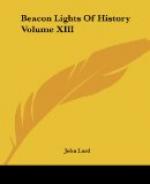Scott’s letters show the man,—frank, cordial, manly, tender, generous, finding humor in difficulties, pleasure in toil, satisfaction in success, a proud courage in adversity, and the purest happiness in the affection of his friends.
How Scott found time for so much work is a mystery,—writing nearly three novels a year, besides other literary labors, attending to his duties in the Courts, overlooking the building of Abbotsford and the cultivation of his twelve hundred acres, and entertaining more guests than Voltaire did at Ferney. He was too much absorbed by his legal duties and his literary labors to be much of a traveller; yet he was a frequent visitor to London, saw something of Paris, journeyed through Ireland, was familiar with the Lake region in England, and penetrated to every interesting place in Scotland. He did not like London, and took little pleasure in the ovations he received from people of rank and fashion. As a literary lion at the tables of “the great,” he disappointed many of his admirers, since he made no effort to shine. It was only in his modest den in Castle Street, or in rambles in the country or at Abbotsford, that he felt himself at home, and appeared to the most advantage.
It would be pleasant to leave this genuinely great man in the full flush of health, creative power, inward delight and outward prosperity; but that were to leave unwritten the finest and noblest part of his life. It is to the misfortunes which came upon him that we owe both a large part of his splendid achievements in literature and our knowledge of the most admirable characteristics of the man.
My running record of his novels last mentioned “The Monastery,” issued in 1820, in the same year with perhaps the prime favorite of all his works, “Ivanhoe,” the romantic tale of England in the crusading age of Richard the Lion-Hearted. In 1821 he put forth the fascinating Elizabethan tale of “Kenilworth.” In 1822 came “The Pirate” (the tale of sea and shore that inspired James Fenimore Cooper to write “The Pilot” and his other sea-stories) and “The Fortunes of Nigel;” in 1823, “Peveril of the Peak” and “Quentin Durward,” both among his best; in 1824, “St. Ronan’s Well” and “Redgauntlet;” and in 1825, two more Tales of the Crusaders,—“The Betrothed” and “The Talisman,” the latter probably sharing with “Ivanhoe” the greatest popularity.




